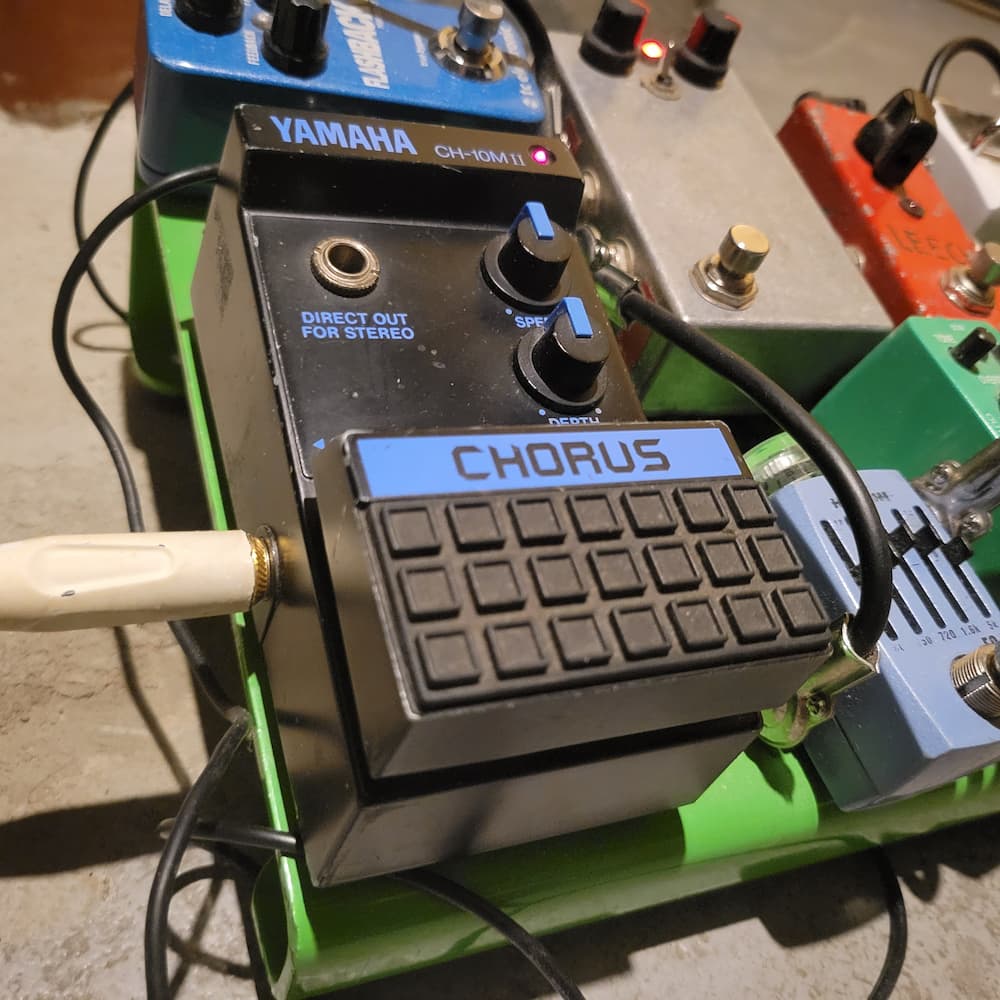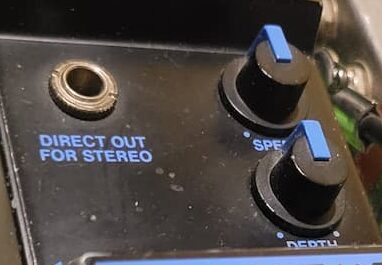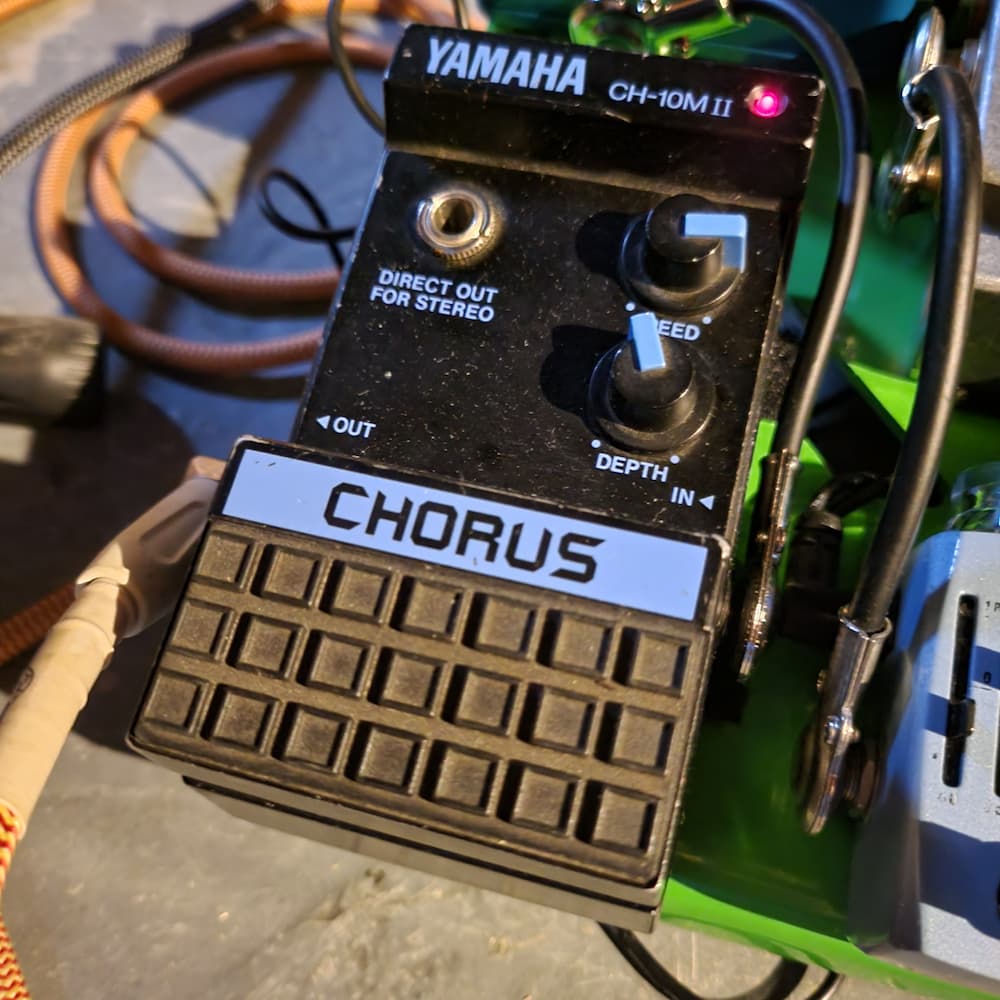Now that Light Audio Recording’s new direction is outlined, let’s get on with it! Without delay, here’s a review of the reasonably-priced Yamaha CH-10MII chorus pedal!
Update, May 23 2025: wouldn’t it be wild if you found your way to this review because you Googled the pedal after you saw mine listed on Reverb? Hah!

Background
The demise of the Clone
I don’t actually remember how I came to be in possession of my Small Clone. I think I bought it off a guy I did karate with for $10, and instantly fell in love with the lush sound. Even when I downsized all my other pedals to the smallest possible equivalents, I couldn’t bring myself to let go of the Clone.
I just checked, and can’t believe I never reviewed it!
However, notably, when I moved to New York, it broke a couple of times. Firstly, if I recall correctly, it was something to do with the footswitch. Following some research, I was able to send it with a check for $25 to Electro-Harmonix directly for repair.
Secondly, a couple of years later, it stopped working again. Possibly the switch again. Off to Electro-Harmonix again with another $25.
When it happened a third time, I had to be realistic. Another $25 to Electro-Harmonix would make $75 just on repairing this pedal. I could get a respectable pedal for that.
So, I went into research mode.
Research
To begin with, I headed to Reverb and started some investigating. At this point, I set an arbitrary budget of around $80.
While I knew the big names, like BOSS and of course Electro-Harmonix, I was down to try something else. Eventually, I had this shortlist:
However, I kept coming back to the Yamaha. Primarily because of its aesthetic – it just reeks of pure vibes! But also, for all Yamaha make, I never knew them for pedals. Tickle me intrigued.
More importantly, though, it was the only one I could find demo videos of. And I liked what I heard.
However, I was strongly tempted by the Hofner. It was just such good damn value! But I couldn’t find any reviews about it, and there weren’t many for sale on Reverb. Therefore, the chance of making a buck from affiliate links was low.
Following a quick message to make sure it took the standard “BOSS” type power supply, I was ready to go.
Yamaha CH-10MII chorus pedal: tech specs
| Construction material | Metal enclosure, plastic knobs, rubber on the switch |
| Voltage | Your standard 9 |
| Power | A 9V battery, or the standard “BOSS” connection from the mains |
| Controls | Just speed and depth |
| Any other cool stuff? | A direct out for stereo use |

Construction
While it’s always tough to evaluate the construction of gear, there were a couple of points that stood out, which I feel attest to the quality of its construction.
Firstly, this is a very old pedal that still works. Although I don’t have an exact date for its production year, it’s from the 80s. Therefore, it is old. We don’t need to speculate any other specifics at this time.
Secondly, everything looks original. However, I’m not a super-gear techy with any kind of training. But everything looks old enough to be original. For example, the knobs are very secure and solid, and the paintwork is 100% visible – not even scratched.
In summary, it lacks the weightiness and the built-like-a-tack feel of a BOSS pedal, I’m confident you could lob it at a drummer’s head and it would be fine. To put it another way, I would pitch its sturdiness at 85% or so of a BOSS pedal.
Tones
So, I’ll get right to my thoughts. As soon as I plugged everything in and stamped on the pedal, I knew it was a keeper.
To demonstrate the pedal, I could cover every minute change you could make, but I’d be here all day. To begin with, I opted for a Strat’s middle pickup with a clean tone.
In order to get the clearest understanding of what the pedal does, I spent a little time playing without it engaged. Then, when I was familiar enough with the unaltered sound, with the speed and depth both set to 12… I stepped on the pedal…
And my world hasn’t been the same since.
When I fell in love with my Small Clone, I thought was it. But, I quickly learned that I was wrong, and felt silly for having clung so religiously to it.
Of course, I could detail everything I did, but here’s a video for you to see and hear, which is way more helpful.
Also, I would be a scallywag if I didn’t share what I used to record this little demo.
- Dell 3100 Chromebook
- TC Helicon GO SOLO audio interface
- Pig Hog 10ft XLR cable
- MXL V67G microphone
- Beyerdynamic DT-240 Pro headphones
- Dean USA Z
- Fender American Standard Stratocaster
- Laney VC15-110
- Pig Hog instrument cables
- Ernie Ball Regular Slinky guitar strings
- Dunlop Gator Grip 1.14mm picks
- Hotone Tuner
- Palmer BatPack 8000
Yamaha CH-10MII chorus pedal: conclusion
In summary, this old Yamaha CH-10MII really captured my eardrums.
One most important aspect of this pedal is to be open-minded when replacing gear. Even though I was so attached to the Small Clone, and it felt like a big decision to make a change, it was the right call.
| Pros | Cons |
| Tone! Although relative to modern digital units, it doesn’t do that much, it does what it does very well. | Age. While this isn’t a con in terms of tone or build quality, it is a curiosity for parts if it needs to be repaired |
| Price. Since I bought mine, and in writing this review, I looked at current pricing. While the prices do vary – looks like between $55 and $80 – it’s still a very reasonably priced pedal. | Stereo output. This also isn’t a real con. But I’m trying to balance out the number of items on both sides, and decided to count this because I haven’t tried it. |
| Vibes. Because just look at it! |

If you found this helpful, subscribe! You’ll be notified of new posts on Thursdays, inspiring you going into the weekend.
And share why you found it helpful. Because it helps us, and others!
Feel free to shoot me a coffee